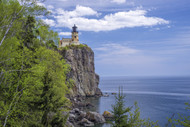Historic American Lighthouses - Split Rock
Posted by American Lighthouses on Mar 25, 2021
One of the most visited spots in Minnesota is the Split Rock Lighthouse. This lighthouse sits on the North Shore, overlooking Lake Superior. As shipping increased on Lake Superior, due to the demand of iron ore, it became necessary to add a lighthouse on the North Shore.
On November 28, 1905, before there was a lighthouse, a storm damaged 29 United States Steel ships. James Oliver Curwood, a writer, stated that the North Shore of Lake Superior was "the most dangerous piece of water in the world." The damage to so many ships led to the United States Steel company president taking action. He and a delegation went to the Capital of the United States and sought to have a lighthouse built on Stony Point. During their attempt to get a lighthouse approved they described the place as Split Rock, and that is how it got its name. In 1907 Congress approved $75,000 for a lighthouse and a fog signal to be built. Three years later, in 1910, the lighthouse was completed.
It was not until 1924 that the lighthouse could be accessed other than from the water. It was that year that the Lake Superior International Highway made the lighthouse a lot more accessible. This road not only meant it was easier for the workers and their families to get to the lighthouse, but it also meant that tourist could come see the lighthouse. In the early 1930’s it is estimated that 5,000 people came to visit the Split Rock lighthouse each year. In 1938, lighthouse keeper Franklin Covell, estimated that nearly 100,000 people came to visit the lighthouse that year. This meant that the lighthouse got 5 times as many visitors as any other lighthouse that was operating at the time.
The Split Rock Lighthouse closed in 1969 due to new technology that made the lighthouse obsolete. In 1971 the state of Minnesota got the lighthouse and its property. Later in 1976 the state turned over the lighthouse and its grounds to the Minnesota Historical Society.
Today the lighthouse has been restored to what it would have looked like in the 1920s. Still today, like in past years, the lighthouse is visited by thousands of people. In 2011 the lighthouse was stated as a National Historic Landmark.

